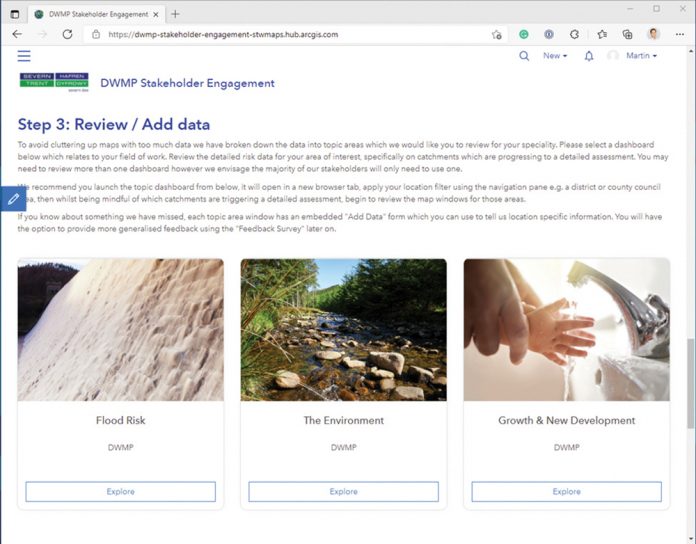Severn Trent
As our drainage and wastewater systems face ever increasing pressures they need to become more resilient. Whilst sewerage companies already carry out wastewater catchment planning to mitigate future risks, these wastewater assets interact with other drainage systems, which are the responsibility of other stakeholders. To support the development of long-term collaborative catchment strategies, sewerage companies are developing Drainage and Wastewater Management Plans (DWMP). In an industry first, Severn Trent has developed an innovative, digitised approach for multiple flood risk management stakeholders to work together, through an interactive, map-centric platform based on Esri’s ArcGIS Hub.
The Challenge
In May 2018, some areas of Birmingham and the West Midlands experienced over a month’s worth of rainfall in one hour. This was not an isolated event. As a result of climate change, extreme weather conditions are becoming more frequent and more intense, and the nation’s drainage systems need to adapt to cope.
The requirement for new housing to accommodate population growth is set to add even more water to the current systems, as well as the surface run-off from this new infrastructure. Ambitious Water Quality requirements for England’s rivers mean that wastewater will need to be treated to a higher standard. Customers and stakeholders also expect continuous improvement in the level of services that Severn Trent provides.
Responsibility for managing such intense rainfall events and surface run-off is split across several organisations, with Lead Local Flood Authorities responsible for water above ground, the Environment Agency responsible for main river flooding and the sewerage companies responsible for the rainfall which overloads wastewater capacity. All risk management and environmental organisations therefore need to look at collaborative ways to improve the development of catchment strategies and plans such as the DWMP.
Previously, Severn Trent would invite organisations and stakeholders across all areas of its wastewater network to attend a series of in-person, interactive workshops. The advent of COVID-19 lockdown restrictions meant that these meetings were no longer possible. What Severn Trent needed was a means to engage with its stakeholders in a socially distanced fashion, where they could provide their input in a structured way.
The Solution
In an industry first, Severn Trent has developed the DWMP Stakeholder Engagement Hub, a multiple-party engagement platform. A seamless extension of its own in-house GIS system, the DWMP Stakeholder Engagement Hub is based on ArcGIS Online and ArcGIS Hub Premium, digitising the previous face-to-face approach.
The company has been a long-standing customer of Esri since 2007 and this latest advancement came about from discussions with Esri around the specific requirements of the DWMP, and how the business could present it to its stakeholders, engage with them and solicit their feedback before considering strategic options.
All or most of the data needing to be embedded in the DWMP already existed on premise or on GISSTOnline, Severn Trent’s ArcGIS Online platform. The team simply needed to configure the data into presentable information products, ie maps, dashboards and surveys, and embed it into their DWMP Hub initiative.
The Hub enables Severn Trent to engage with local stakeholders in a socially distanced fashion. Engagement with stakeholders is done in a very structured way and it has direct control over how stakeholders can access the DWMP information and how stakeholders can submit their input. The data presented in the Hub comes directly from the company’s core systems on top of the common geography, and the feedback comes in pre-defined forms which makes follow-up modelling much easier. Users simply log into the Hub and can make their input in as little as ten minutes.
Severn Trent was aware that other organisations are facing constant resource challenges which had been exacerbated by the ongoing pandemic and so wanted to ensure the Hub was simple to use, with flexibility to allow stakeholders to access the Hub at a time to suit their busy work schedule.
The uptake has already been significant, seen as an important marker of success, given there is no statutory obligation for stakeholders to respond. The first consultation was shared with over 200 stakeholders with an uptake of almost 50 per cent, an unprecedented figure. Previously, no more than 25 per cent of stakeholders would have attended a face-to-face meeting, meaning the company now has twice as much data from initiating this digital approach, which will ultimately enable Severn Trent to identify the most impactful options across all types of drainage.
Benefits
Speedy set up
The DWMP Hub was quick to set up, as all or most of the data already existed in the company’s ArcGIS Online account. The data was easily configured into visually engaging maps and dashboards, its UI design being acknowledged as a key element in the Hub’s success.
Digitising data collection
Severn Trent has exact control over how stakeholders can access the DWMP Hub empowering feedback in a more structured way. Stakeholders can submit their feedback digitally, rather than having to travel to and attend meetings out of the office. Since inception, responses have more than doubled.
Sharing of Information
With feedback coming through in predefined forms, follow-up modelling by the Severn Trent team is much quicker. This content can then be presented as the Drainage and Wastewater Management Plan and published out to stakeholders and other parties including Ofwat. It is Severn Trent’s intention that this Hub platform will ultimately be used to share the findings of the DWMP process, with the draft being published for consultation in Summer 2022.
Collaborative approach
Bringing together invested stakeholders digitally and identifying ways in which to solve flooding and wastewater issues, drives participation and engagement. Presenting information via charts and maps makes it easier for everyone to have a shared understanding of the goal, which can pave the way to action and potentially solving other problems.
To find out how ArcGIS enables organisations to collaborate more effectively with stakeholders in the water industry, visit
esriuk.com/water or contact Craig Hayes, head of Critical National Infrastructure at Esri UK on 01296 745599 or sales@esriuk.com




